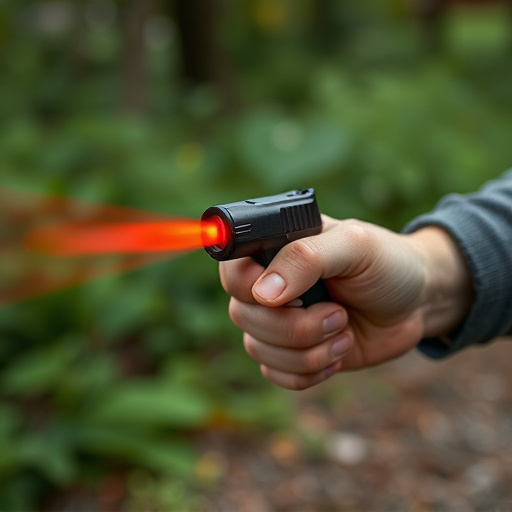Police-grade tactical pepper spray, a capsaicin-based compound, temporarily disables targets by irritating eyes, skin, and respiratory systems. Effective deployment through aerosol canisters, hand-held units, or ballistic devices allows officers to control situations while minimizing collateral damage. Specific training teaches officers precise targeting techniques, such as aiming for the eyes and nasal passages from a safe distance (2-3 meters), ensuring controlled responses and reducing harm to bystanders or self. Adhering to strict protocols, de-escalation strategies, and legal guidelines balances crowd control with potential risks associated with tactical pepper spray deployment methods.
“Uncovering the power and purpose of police-grade tactical pepper spray, this comprehensive guide delves into the intricate details of its chemical composition and potent effects. From understanding the active ingredients to mastering deployment techniques, we explore how law enforcement agencies leverage this tool for crowd control and self-defense. Additionally, we shed light on safety precautions and legal considerations surrounding its use, emphasizing responsible tactical pepper spray deployment methods.”
- Understanding the Chemical Composition and Effects of Police-Grade Pepper Spray
- Tactical Deployment Techniques for Optimal Effectiveness
- Safety Considerations and Legal Implications of Using Pepper Spray in Law Enforcement
Understanding the Chemical Composition and Effects of Police-Grade Pepper Spray
Police-grade tactical pepper spray is a specialized compound designed for law enforcement and military applications, offering a powerful non-lethal force option. Its chemical composition typically involves capsaicin, the active ingredient found in chili peppers, which irritates the eyes, skin, and respiratory system. This irritation triggers a temporary but intense response, disabling the target without causing permanent harm. The spray’s effectiveness lies in its precise delivery methods, allowing officers to deploy it strategically during various tactical scenarios.
The deployment methods of tactical pepper spray are varied and tailored to different situations. These include aerosol canisters, hand-held aerosol units, and ballistic devices that shoot specialized projectiles containing the spray. Each method ensures a quick release of the compound, enabling officers to control and subdue individuals efficiently while minimizing collateral damage. The versatility in deployment methods makes police-grade pepper spray a versatile tool, contributing to effective crowd control and tactical operations.
Tactical Deployment Techniques for Optimal Effectiveness
When deploying tactical pepper spray, understanding the right techniques is key to maximizing its effectiveness during high-stress situations. Law enforcement officers are trained to employ these methods, ensuring a swift and controlled response. One common tactic involves aiming for the face, as the eyes and nasal passages are sensitive areas, causing temporary blindness and respiratory distress. This direct approach can disable an aggressor or subject quickly, allowing officers to regain control of the scene.
The method of deployment also includes utilizing proper distance and angle adjustments. Pepper spray is most effective when sprayed directly into the face at close range, typically within 2-3 meters. Officers should be cautious not to overspray, which could potentially harm bystanders or reflect back onto themselves. Techniques like the “push-and-pull” method, where the officer gently pushes the subject away while spraying, can help control and disorient them without causing prolonged damage.
Safety Considerations and Legal Implications of Using Pepper Spray in Law Enforcement
In considering the safety considerations and legal implications of using tactical pepper spray deployment methods in law enforcement, it’s crucial to balance effective crowd control with potential harm to individuals and communities. Pepper spray, while designed as a non-lethal force option, can cause severe discomfort, breathing difficulties, and even long-term health issues for those affected. Law enforcement agencies must strictly adhere to protocols that dictate when and how pepper spray should be used, ensuring it’s only deployed as a last resort when other de-escalation tactics have proven ineffective.
Legally, the use of pepper spray is subject to varying regulations across jurisdictions, with many regions setting out specific guidelines on its deployment. These laws often emphasize proportionality, requiring officers to assess the level of threat before resorting to such force. Moreover, proper training in tactical pepper spray deployment methods is essential to ensure officers understand their responsibilities and potential liabilities. This includes recognizing medical conditions that might make individuals more vulnerable to the effects of pepper spray, as well as de-escalation strategies to avoid its use altogether.
Police-grade pepper spray, with its potent inflammatory compound, is a valuable tool in law enforcement when deployed tactically. Understanding the chemical composition and learning effective deployment techniques can maximize its effectiveness while ensuring safety and legal compliance. By adhering to best practices, officers can utilize tactical pepper spray methods for optimal control during critical situations, making it an indispensable asset in modern policing strategies.
